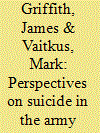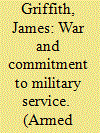| Srl | Item |
| 1 |
ID:
124061


|
|
|
|
|
| Publication |
2013.
|
| Summary/Abstract |
Suicides in the US military were observed rising in 2004, most notably in the Army and Marine Corps, and particularly, in the Army National Guard (ARNG). Alarmed, Army leaders and researchers have offered various explanations and prescriptions, often lacking any evidence. In the present study, three data sets were used to examine evidence for various perspectives on suicide-dispositional risk, social cognitive, stressor-strain, and social cultural/institutional, each having different emphases on relevant explanatory variables and underlying mechanisms of suicide. Primary risk factors associated with having committed suicide among the 2007-2010 ARNG suicide cases were age (young), gender (male), and race (white), supporting the dispositional risk perspective on suicide. Some evidence supported the stressor-strain perspective in that postdeployment loss of a significant other and a major life change showed statistically significant, yet weaker associations with increased suicide intentions. Implications of results are discussed for future research and preventive strategies.
|
|
|
|
|
|
|
|
|
|
|
|
|
|
|
|
| 2 |
ID:
187102


|
|
|
|
|
| Summary/Abstract |
The present study examined career intentions in two samples—home-based or garrison (N = 12,583 soldiers in 180 companies) and deployed and recently returned soldiers (N = 4,551 in 50 companies). Proportionally, fewer deployed soldiers than home-based garrison soldiers intended to stay in reserve military service. Among deployed soldiers, those who reported having experienced combat trauma, having had wounded or killed someone, and having had a friend killed in combat were less likely to plan to continue military service; reservists more likely to continue military service had returned to the same civilian job after deployment. Among deployed and garrison soldiers, fewer financial difficulties were associated with higher likelihood of continuing reserve military service. Examples from the social constructionist perspective of reserve military service are used to elaborate on mechanisms in these associations.
|
|
|
|
|
|
|
|
|
|
|
|
|
|
|
|